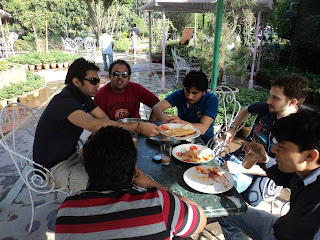As I traveled through Jaipur last weekend, a driver told me, “In India, everything is possible.” It’s true -- as with the rest of India, Jaipur is a fascinating but intense place. Jaipur is the capital city of Rajasthan, a mountainous desert state in western India. Other than the pickpocketing – which turned out okay – it was a pretty good weekend:
- After spending all day in a sleeper train – which was both awkward (I was unable to sit up for five hours) and very nap-conducive – I headed straight to the Pink City. The maharaja ordered the old city of Jaipur painted pink to welcome the Prince of Wales in 1876, and since then residents are required to maintain the color. First stop was Hawa Mahal, a five-story beehive-shaped building where royal ladies used to go to view the streets. It looks larger on the inside than the outside, and it has some amazing views of the city. Next was Jantar Mantar, an ancient observatory filled with oddly-shaped structures used to measure the stars and sky. For a while I sat on the lawn in between the structures; it was one of the most unique places I’ve ever seen.· I linked up with the only other volunteer on my program in India, as I only recently learned of her existence. We took a rickshaw up to Nahargarh Fort, up on a hill with a spectacular view of the city. We were some of the only people there, though there were plenty of peacocks, some of whom were engaged in mating dances for their lady-friends. Afterward we went out for Rajasthani food, which was delicious but hard to identify and very spicy. I was so grateful when someone brought me curd (yogurt) to counter the spice, I literally blessed him.· My favorite stop was Amber Fort, another massive fortification outside of the city. The building was incredibly impressive, with walls covered in mosaics and endless patterns of mirrors, as well as subterranean tunnels running to a neighboring fort. Were it not for the massive heat, I could have stayed there all day. Instead I picked an indoor venue: a historical art museum in Albert Hall, in the new city of Jaipur. The collection was very impressive, but mostly I was happy to be inside.· Residents would approach me every ten feet and want to be my friend. Often they weren’t selling something (so far as I could tell), but the intensity of the attention was certainly new. It felt like the notice a minor celebrity would receive, only now for all foreigners. The approach was always the same, almost verbatim: “Can I ask you just one question? Why don’t foreigners like talking to Indians?” Usually they asked me to tea, but I was also invited to ride on a motorcycle, to play in an elephant village (tempting), and to stay in someone’s home with their family. It was sweet (I think), but they couldn’t understand why I declined. (Him: “I get it; you don’t trust me because I’m Indian.” Me: “No, I don’t trust you because I don’t know you. I wouldn’t get on your motorcycle in the States either.” That didn’t make him any happier.) Also, everyone wanted to take a picture with me. My favorite: “Can I take a picture of you? Great. Here, hold my baby.”· The trip back was mostly uneventful, until someone pickpocketed me on the metro. After rearranging something in my bag, I almost immediately noticed that my wallet was missing. Since we were still between metro stops, I knew my wallet was within five feet of me. I started making a lot of noise, hoping someone saw something. Fortunately a woman pointed out who lifted the wallet. I started to frisk him as he stood there impassively. The woman then pointed out that he dropped the wallet on the ground. I grabbed it – with everything still inside – but I was pretty on edge afterwards. He had lifted it out of the side pocket of my jeans – how is that possible?· Pictures: 1) Hawa Mahal, 2) Jantar Mantar, 3) Nahargarh Fort, 4) Amber Fort















